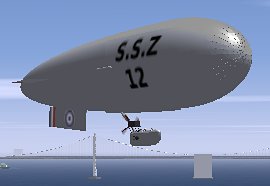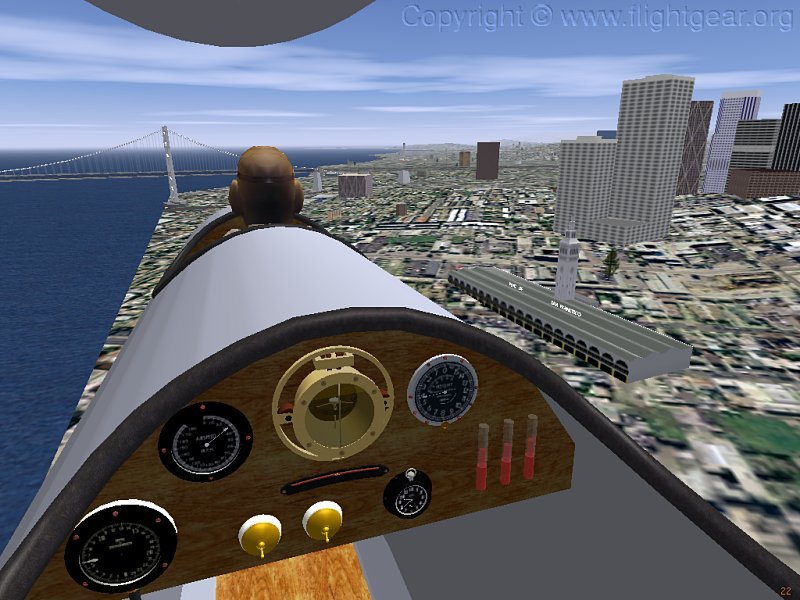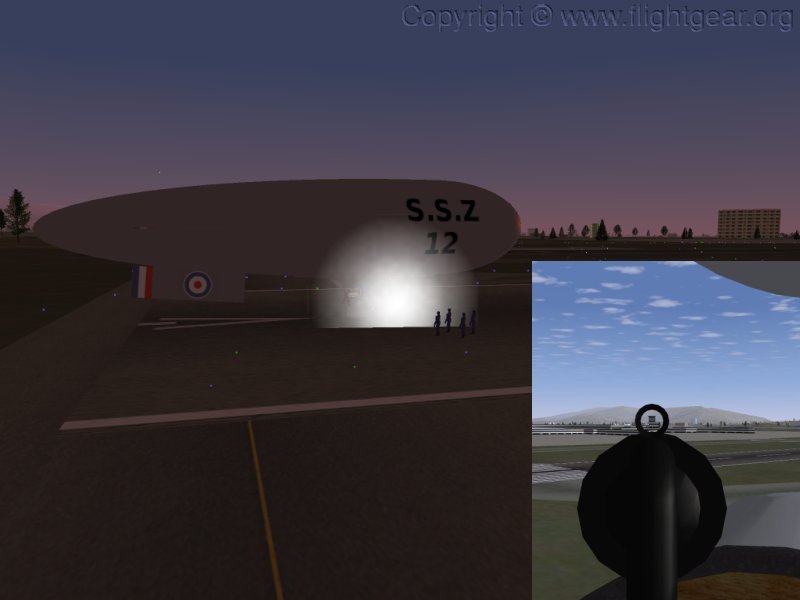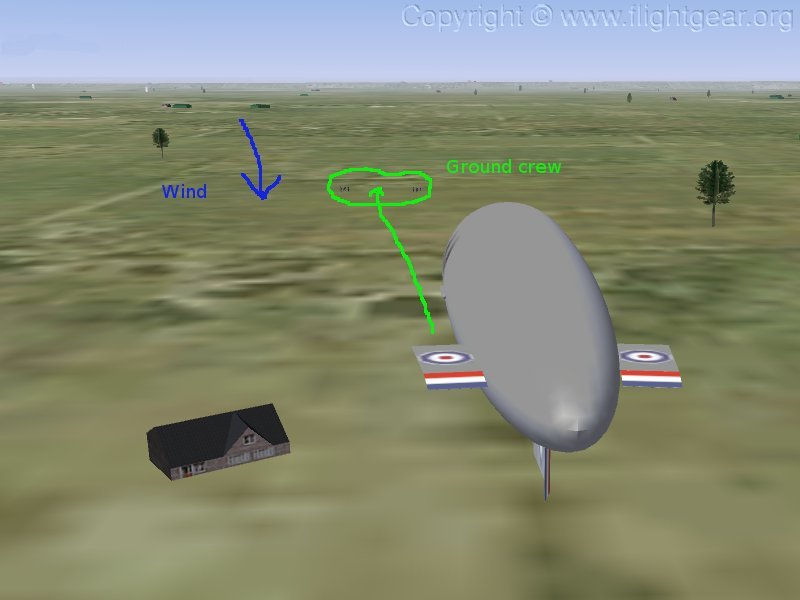Submarine Scout
 | |
|---|---|
 | |
| Type | Airship, Aerostat, Military airship |
| Author(s) | Anders Gidenstam |
| FDM | JSBSim |
| --aircraft= |
Submarine_Scout Submarine_Scout-observer |
| Status | Beta |
| FDM |
|
| Systems |
|
| Cockpit |
|
| Model |
|
| Supports |
|
| Development | |
| Website |
|
| Repository |
|
| Download |
|
| License | GPLv2+ |
|
| |
The Submarine Scout was a fairly small blimp, i.e. non-rigid airship, which was used for maritime patrol and convoy escort by the Royal Naval Air Service (RNAS) during World War I. The type first flew in 1915 and was in service throughout the rest of the war. The early versions had cars made from slightly modified aeroplane fuselages; the final version, Submarine Scout Zero represented here, had a purpose built car.
Handling instructions
Important controls / keys / instruments
Flight controls
- Rudder (Aileron input is transferred to the rudder for convenience.)
- Elevator
In the real aircraft the pilot had rudder pedals for the rudder and an elevator wheel located in front of him (with its axis across the cockpit) for the elevators.
Ballast
| Key | Function |
|---|---|
| W | Weigh-off to 50 lbs heavy by adjusting ballast. Takes about 10 seconds and only works when on the ground. |
| w | Show current on-ground weight. Only works when on the ground. |
| D/d | Drop ballast in 1%/0.1% decrements. (Rarely used.) |
This type of blimp normally operates from about 100 lbs heavy to a few 100 lbs light.
Gas and Envelope
| Key | Function |
|---|---|
| F/f | Open/close the gas valve. |
| Q/q | Open/close fore ballonet relief valve. |
| A/a | Open/close aft ballonet relief valve. |
| Ctrl+Q | Open/close fore ballonet inflow valve. |
| Ctrl+A | Open/close aft ballonet inflow valve. |
The fore and aft ballonets (air-filled bags inside the envelope) serve two purposes: (i) by inflating/deflating they maintain the pressure differential and volume of the envelope when the gas changes volume (mainly due to altitude changes); and (ii) the trim of the airship can be changed by the relative inflation of the ballonets. While the required envelope pressure dictate the total volume of the ballonets the airship can be trimmed by having one ballonet more or less inflated than the other.
The ballonets are inflated by air from the propeller slip stream, collected with the scoop and passed via fabric trunks and closeable no-return valves to the ballonets. The ballonet relief valve automatically open when the pressure in the ballonet exceeds a set limit (which is lower than that of the gas relief valve to prevent gas being valved before both ballonets are empty). Maintain the envelope pressure at about 15 - 25mm water, shown by the height difference between the outer and inner fluid in the manometers (which have no scale yet!).
The gas valve is basically only used to valve some gas if the airship is found too light during the pre-landing weigh off.
In the version released with FlightGear 1.9.0/1 both ballonets continuously received a constant in-flow of air instead. The degree of inflation (and total pressure) is controlled by "bleeding" more or less air from either ballonet relief valve.
To trim towards:
- nose heavy - open the fore ballonet inflow valve and the aft ballonet relief valve (nose gets heavier / tail lighter).
- tail heavy - open the aft ballonet inflow valve and the fore ballonet valve more (tail gets heavier / nose lighter).
Don't open the ballonet relief valves too wide or the envelope pressure will drop too low. Monitor the pressure gauges! You might need to rev up the engine to restore the envelope pressure at times (in particular when descending).
Ground crew
| Key | Function |
|---|---|
| U | Request ground crew to prepare for landing. |
| Y | Tell ground crew to let go. Do this before you take-off. |
| Alt + click on terrain | Place the ground crew. |
On the prepare-for-landing request the ground crew will align to the current wind conditions. When landing you should aim to approach against the wind and arrive exactly in between the left and right ground teams with very low speed and altitude.
The ground crew is visible over the multiplayer network.
Cockpit and instruments
Upper row left to right: Airspeed indicator, Compass and Altimeter (Note: The altimeter reads in 100s rather than 1000s feet).
Lower row left to right: Tachometer, Left and right magneto switches, Clinometer, Watch, Pressure gauges for fore ballonet, main envelope and aft ballonet.
Armament
The Submarine Scout airship is armed with two 65lb bombs. The bombs can be dropped one at the time by actuating the default weapon trigger from the pilot view. Bomb impacts are visible over the multiplayer network.
Note: By default the weapon trigger is not mapped to any control in FlightGear. However, most joystick configurations put it on a button or a button + key combination.
ALDIS signalling lamp
The observer view has an ALDIS lamp for morse code signalling. The ALDIS lamp can be picked up or stowed in the observer view by clicking the lamp handle. The lamp is actuated by the default weapon trigger in all views except the pilot view. The lamp state is visible over the multiplayer network.
Airship piloting
Static controls
- Buoyancy
- Weight
- Envelope pressure
- Trim
Checking the static condition
There is no instrument on the Submarine Scout that directly show if the airship is light or heavy and what the static trim is. To see you have to reduce throttle to idle and wait for the speed to decrease. As the aerodynamic forces diminish the airship will start to rise or descent depending on its lightness/heaviness and its pitch attitude will show how nose/tail heavy it is.
To some extent the lightness/heaviness is also apparent in how the 'ship handles at speed - a heavy 'ship requires a nose up attitude to maintain altitude - while a light ship requires a nose down attitude.
Dynamic controls
- Rudder
- Elevator
- Throttle
Basic manoeuvres
Take-off
- Set ballonet valves to 0%/2% (fore/aft). This will slowly make the ship more nose heavy which is suitable for cruise.
- Tell ground crew to let go (Y).
- Check weight (w) and weigh off (W) as necessary. 50 lbs or less is a good take off heaviness. Note that each weigh off takes 10 seconds to complete.
- Start engine (magnetos on + s).
- Take off at full power and a nose up attitude.
- When the nose starts to swing up use some down elevator to increase(!) lift and avoid a tail strike.
Landing
Note: You can position the ground crew by Alt+click on the terrain.
- Check static condition and trim: Neutral trim and slightly heavy is better than light. Check the static condition and trim by stopping the engine and note whether the airship raises or falls as the airspeed drops off and what pitch attitude it tends towards.
- Prepare the ground crew (U). They will (re)position themselves facing the wind.
- Approach is against the wind, low (~150ft) and slow.
- Aim to arrive between the handling parties, below 100ft and with very little ground speed.
- The ground crew uses the handling guys to secure the ship.
Installation and Dependencies
Known problems
- The ground handling force calculations are sensitive to long frame times (i.e. very low fps), which can cause FlightGear to crash during startup or make the airship start in a bad state.
Workaround: Set /sim/max-simtime-per-frame to 0.1 seconds or less. This can be done in preferences.xml by modifying the line
<max-simtime-per-frame>1.0</max-simtime-per-frame>
to
<max-simtime-per-frame>0.1</max-simtime-per-frame>
External links
- My GitHub repository for the Submarine Scout aircraft.
- Download page with other lighter-than-air aircraft for FlightGear. Note: The most up to date version of the Submarine Scout is available in my GitHub repository.
- Submarine Scout Class information at the Airship Heritage Trust
| |||||


